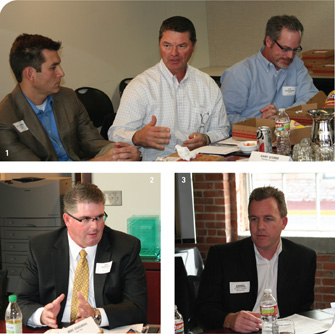
1. Gary Storm, center, noted the challenge of aligning engineering firms’ interests with programming possibilities at universities. | 2. Mike Odrowski, singling out the use of high-level design tools even in high schools, called the trend “amazing.” | 3. Darren Hartman said that, almost without fail, engineering interns say they learn more over the course of a summer than they have in two years of classroom education.
“I think we definitely should be,” said Darren Hartman of Thornton Tomasetti. On the application side, he argued, it would be helpful if the firms offered joint programs with universities. The reason is obvious: “Every engineering intern that we’ve had come in during the summer says that they’ve learned more in the three months they’ve been with us than they did the previous two years” of school.
Part of the challenge, cautioned Gary Storm, is that if all the firms were asked which program they would like their graduate to be proficient in, there might be as many different answers as there were firms.
Kevin Honomichl served on the civil engineering advisory council at K-State and acknowledged that universities already face “tons and tons of pressure to cram more into the programs.” Much of that pressure involves “the soft skills.” Honomichl was not sure that was a good idea. “What the university needs to do is teach students the technical aspects.” The rest, like management and leadership skills, could be acquired through continuing education.
Jim Lewis spoke positively about the five-year programs that have a built-in business component. “Understanding business helps,” he argued, especially if the business piece is not just crammed in.
With regard to talent development, Mike Fenske contended that student retention was a continuing problem for engineering schools. Fenske questioned whether firms could help schools devise ways to improve retention without watering down the coursework.
Mike Odrowski has been encouraged to see more exposure to engineering at the high-school level. What attracts students, he believes, is the technology. There are several different school districts now that are teaching high school students Autodesk Revit Architecture and that, said Odrowski, “is pretty amazing.”
“That is the kind of model that’s really great to bridge the gap between academia and what the real world is,” said Cliff Greenlief. As he sees it, these technologies help students understand what engineering means early enough to make an informed decision about their careers.
“There are high schools that seem to be reaching out,” said Mike Owens. He has gone to a few to talk about what the engineering profession entails. “It’s a pretty stressful time,” he said about high school, “and any information students can glean from anybody in the profession, I think, is a big deal.”
Joe Marsh would like to see the exposure begin even earlier. “If they don’t get started in middle schools,” said Marsh, “they don’t get enough math and science in high schools to be prepared to go to college.”
Jim Lewis cited some additional student-oriented programs like the FIRST Robotics competition, Project Lead the Way for middle and high school students, and now the Kansas City STEM Alliance—for Science, Technology and
Math—funded by the Kauffman Foundation. “More and more, we’ve got to get to middle school,” said Lewis. “They all see doctors and lawyers and nurses on TV, but you don’t have engineers on TV.”
Mike Fenske agreed that there was a need to manage the perception of what an engineer is and does. “There is a bigger picture,” he argued, “a relevance in the community.”
Steve Hofmeister is part of a high school mentoring program called ACE. What he has learned through ACE’s research is that students exposed to architecture, engineering and construction in high school are more likely to stay in those programs in college should they choose to enroll.
As to the teaching of engineering, John Skubal, Kaw Valley Engineering’s business development officer, shared his experience on the UMKC advisory board.